
Hanging Drywall with a Cordless Screwdriver
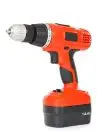 Most Drywall Hangers use drywall screw guns to install gypsum panels. A screw gun in many ways is basically and electric drill with some added features. These features make it well suited for installing drywall. If you don't have a screw gun you can use a cordless drill to install drywall. However, you need to be aware of a few important drywall hanging techniques, most importantly, screw head depth.
Most Drywall Hangers use drywall screw guns to install gypsum panels. A screw gun in many ways is basically and electric drill with some added features. These features make it well suited for installing drywall. If you don't have a screw gun you can use a cordless drill to install drywall. However, you need to be aware of a few important drywall hanging techniques, most importantly, screw head depth.
Don't allow the screw head to puncture the paper
Drywall is made up of compressed gypsum squished between two thin pieces of paper. The gypsum is strong when wrapped with paper but easily crumbles on its own. A screw or nail exerts force on the surface of the paper. The paper layer distributes some of this force across a section of the gypsum below thus holding the sheet of drywall to the wall. If the head of the screw or nail penetrates the paper and rests directly against the gypsum within, the fastener loses its ability to hold because the gypsum simply crumbles under to the pressure of the fastener.
Take an ice cream sandwich as a crude yet helpful example. The entire sandwich is supported by the surrounding graham cracker layers. The ice cream between has little if any strength. You can hold the ice cream sandwich between your fingers only because of the cookie layers. The pressure of your fingers against the sandwich is distributed evenly over the surface of the ice cream layer by means of the cookie layers.
If a screw head punctures the paper layer the drywall will move slightly in this area. Screw pops, a term that refers to a certain type of imperfection in the painted surface of drywall, are the common result of improperly sunk screws. Drywall finishers or even painters usually get the blame for these types of imperfections; however the cause is directly related to the techniques used in drywall installation.
With this in mind using a cordless screw gun means you must be extremely careful when sinking screws into drywall. Screws should be sunk deep enough so that a drywall knife will skim over the top without touching it. If a screw sticks out even slightly it is called a "clicker" because it "clicks" when scraped with a drywall knife. While screws cannot be left above the surface of the drywall paper the head of the screw should not completely puncture the paper either. If it punctures the paper, it looses all holding power, and is best either removed or secured with screws above and below.
There are drill bit accessories that have a built in guard. These bit accessories are referred to as drywall screw setters or drywall screw dimplers. The purpose of a screw dimpler is to prevent the screw from sinking too deeply through the surface of the drywall. The guard hits the paper and stops the Phillips head screw bit from driving the screw any further into the board.
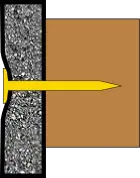
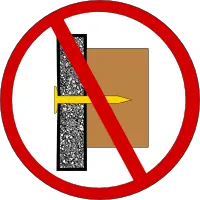
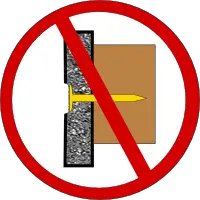
Choosing a Drywall Screw Dimpler
There are quite a few options for screw dimplers on the market. They are sometimes referred to as screw setters.
Molded Screw Dimpler or Screw Setter
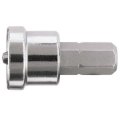
The less expensive screw setters have a guard that is welded or molded directly to the Phillips head screw bit. Since the guard is part of the bit it spins at the same rate as the bit. When the dimpler guard comes in contact with the drywall paper, it can dig in or scuff the surface of the paper causing the drywall to tear away. This can cause problems for the drywall finishers when they coat the screws. If the finished surface will be textured the problem may not be as noticeable, however in smooth wall applications the torn paper will be visible after painting.
Spring Loaded Clutch Release Screw Dimpler
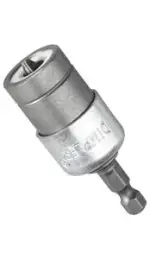
The second type of drywall screw setters or dimplers are spring loaded. Included is a clutch release that reduces drywall tear out. To accomplish this, when pressure is placed against the Phillips head bit the clutch engages allowing the bit to spin and drive the screw. The guard does not spin, therefore it reduces the risk of drywall tear out. Once the Phillips head bit has reached proper depth, the clutch disengages the bit and prevents it from driving the screw any deeper. Some clutch release screw dimplers also have adjustable depth guides. If you adjust the depth guide at all, make sure to keep the principles above in mind regarding screw head depth.
Using a Drywall Screw Gun
Drywall screw guns are the best option for hanging drywall when your fastener of choice is drywall screws. These specialized electric drills have a few options specially designed for drywall. The RPM rate is generally between 5800 and 6000 RPMs which is higher than general use electric drills. They have a switch located somewhere near the trigger switch that allows the operator to lock the drill in the on position which helps reduce trigger finger fatigue. The most important feature is an adjustable depth guard. Because of the different properties of wood vs. metal studs, the screw gun may tend to sink screws slightly differently. Operator applied pressure when installing screws can also affect the depth; therefore the adjustment on the screw guns is critical to attaining proper screw depth as outlined above.
You can buy a good quality drywall screw gun at most big box stores or many online retailers. On average a new gun is around $90.00 to $100.00. Many places run special deals even selling two screw guns for the price of one. For most small DIY projects you may be just fine buying a screw dimpler to compliment your cordless drill. If your project is slightly larger you may want to look for a deal on drywall screw guns. You may be able to find one for around $50.00. There is a learning curve when first using a screw gun, therefore if you are not interested in taking the time to familiarize yourself with it you may be better off using a screw dimpler or just hiring a professional.
What size screw bit is used for drywall screws?
Drywall screws have a standard head size. You will need a number 2 screw bit to install drywall screws. The screw dimplers mentioned above should come with that size screw bits. If you find a screw dimpler with a different size Phillips head bit, it probably is meant for some other construction application. Drywall screw guns are usually sold with a number 2 screw bit. It is good to have some replacement screw bits on hand if you are doing a lot of work since they tend to wear out eventually.
Conclusion
Yes you can use a cordless drill when installing drywall, however a drywall screw gun is the tool of choice for professionals. Regardless of the method used, the most important thing to remember when sinking screws in drywall is screw head depth. Screw dimplers can help ensure proper depth.
